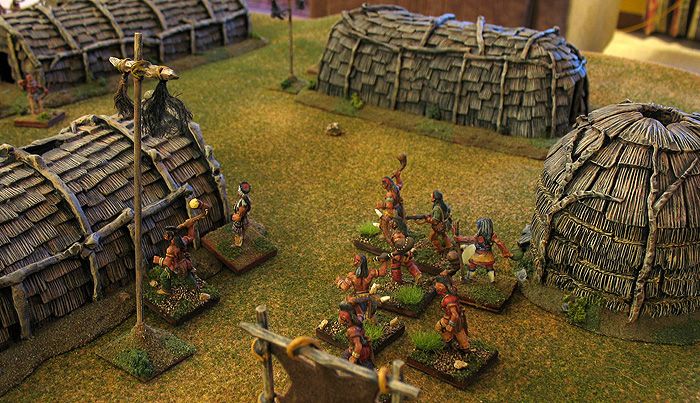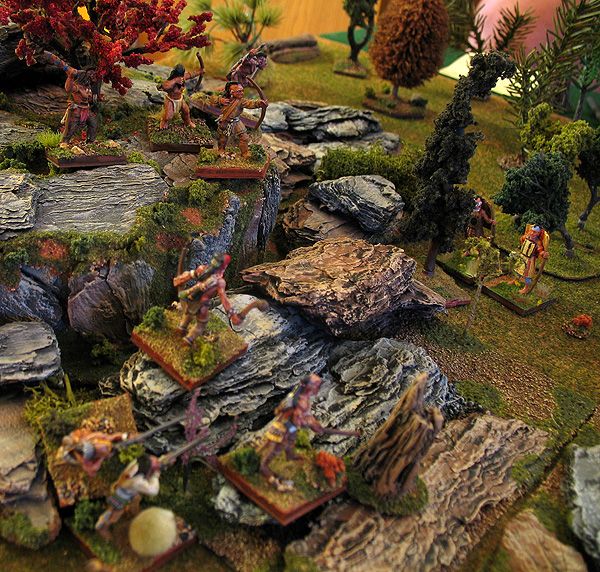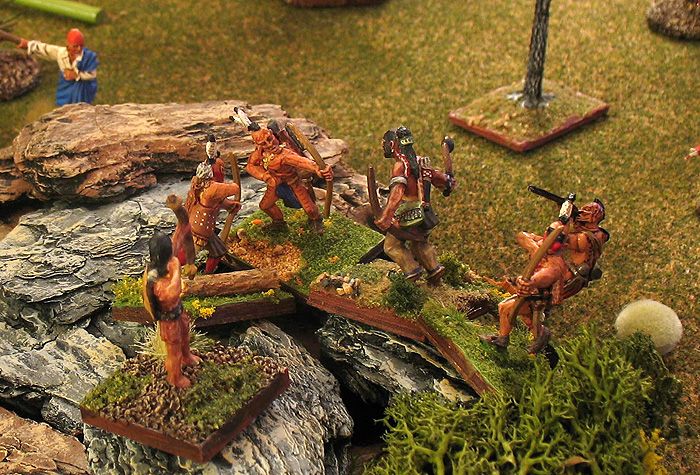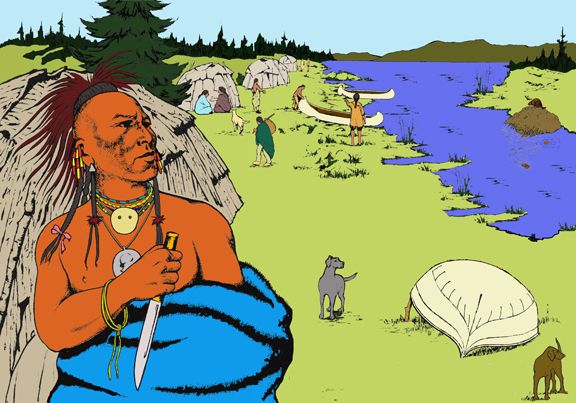Four of us got together to fight out the last two battles. In one, the Ojibwe were attacking another Potawatomie village. In the other, the Seneca sought to take over the last of the Illinois towns. Keith showed up to help us fight them out, so he fought Steve's Ojibwe while I tried to hold the ground for the Illinois. Since we had fought all six choices for "Invasion" battles, I set up both boards before the players arrived. One would be a battle amidst the longhouses and wigwams of the Potawatomie village. The other would be fought in the woods near a rocky outcrop just outside of the Illinois village.
The intervening weeks had seen us reflect on the performance of "Youths" in the campaign. We all felt they were simply too weak and not worth the cost even at 2 Youths = 1 Warrior. Keith and I exchanged emails and came up with something we liked. We would improve their Quality score from 5 to 4. We would also give them the "Woodsman" trait, meaning they could move normally in the woods rather than slower. However, to balance it out, we gave them the "Wavering" trait, which meant they would be -1 on morale checks. Keith ran the points and found that, when both were armed with a Bow, they came out to exactly half of a warrior's point value according to the Song of Drums and Tomahawks point system. Perfect!
 |
| Seneca warriors form a firing line to snipe with my Illinois defenders |
In my battle against Mike's Seneca, I formed the Youths up as a second line. Think of them as "linebackers." In Song of Drums and Tomahawks rules, you must fire at the closest enemy (unless he is a worse shot because of cover or whatever). So, I was careful to make the Seneca target my Warriors, who at a Combat score of 2 should be more survivable than the Youth's 1. This worked for the most part, except it meant that as I lost troops, I lost my tougher and more experienced warriors. Mike wasn't as careful with his Youths, which meant I picked off a number of them. It was a heck of a battle, though. Both of us had to take "Below 50%" moral checks. It came down to my Illinois Chieftain and 3 Youths vs. the Seneca Chieftain and 2 Warriors. I got a bit risky with my leader and he was killed. The Youths fled back towards their lines, and we decided to call the game. The Seneca invasion force had been bloodied, but they held the field of battle and collected their scalps.
 |
| Potawatomi braves attempt to defend their town from the Ojibwe invaders |
 |
| The campaign map at the end of turn 4 |
Afterwards, I wanted to talk to the players about how the campaign was progressing. Although Keith, Steve, and Mike were all very positive about how it was playing, I had some issues. It came to four main points that I did not like about the way the rules were written at this point. These were:
#1 - The campaign system meant that usually not everyone had a battle to fight in each turn. When tribes chose to "Trap & Hunt" or "Visit the Trading Post," they usually would not have a battle. This meant they were often relegated to sitting and watching the others play. To me, that was unacceptable on a gaming evening. Sure, it might work in a large club, where there are plenty of other things to do. But in a small gaming group meeting on an evening to do a turn of Beaver Wars, I don't like some people not being able to play.
#2 - Players were being knocked out of the campaign. Joel's Potawatomie were essentially knocked out only 1/3 of the way in. Some have no problem with this type of game. Think of "Risk," for example, which always results in players be knocked out one by one. To me, that is old school, and I would rather have all my players involved up till the end. The lower ranking ones may have no chance of winning, but they should still be able to show up and do something.
 |
| My Illinois tribesmen cluster atop a rocky outcrop in attempt to hold off the Seneca attack |
#4 - Keeping track of individual experience points for figures that survived battles was too much. I had suspected this might be the case going in, but four turns of the campaign proved it would be a lot to ask of prospective players or GMs. I wanted the system to be more elegant and simple. Keeping track of each warriors's XPs and then what traits he has purchased was simply too much logistics for a campaign I wanted to produce.
So, was Beaver Wars done? No. I had been brainstorming ideas in the week leading up to our evening and had come up with some ideas to retool the campaign. After getting the players' input on the campaign, and asking their feedback on the four issues above, I presented my ideas to them. All three liked the ideas I had to change Beaver Wars and make it more simple and elegant. They gave a couple suggestions to the new system that I liked, as well.
 |
| The clash between Seneca and Illinois gets bloody and up close as Indian warriors and youths close to hand-to-hand |
So, watch this blog for the start of Phase 2 of the Beaver Wars playtest. We may even try out the earlier, mid-1600s campaign which features the initial Iroquois onslaught into the Ohio area. It will give us more chances to test our rules adaptions for the early period, as well. I hope you have enjoyed reading this account of the Beaver Wars. Yes, unfortunately the changes and more playtesting means it may be more months before the rules are published. A bright spot is that the retooling will require more scenarios which will be included in the rule book. So, even those who don't want to play out a 10-turn campaign may be interested in a supplement that contains dozens of scenarios. I am more excited about the final product now than I was before, and think purchasers will get much more bang for their buck!

